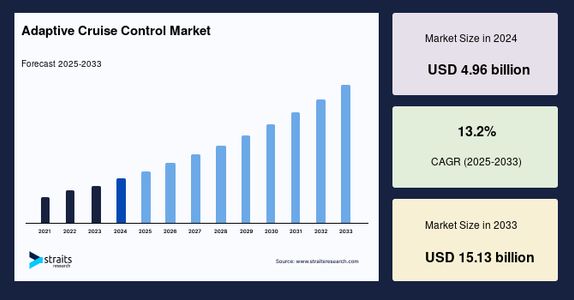Adaptive Cruise Control Market Size Soars: 13.2% CAGR Projection Analysis
 Dhiraj Patil
25 Aug, 2025
7 mins read
3
Dhiraj Patil
25 Aug, 2025
7 mins read
3

The global Adaptive Cruise Control Market is experiencing unprecedented growth driven by escalating traffic congestion, stringent safety regulations, and rapid advancements in autonomous vehicle technologies. As urbanization intensifies and road safety concerns mount, adaptive cruise control systems have emerged as essential automotive features, transforming from luxury add-ons to standard safety equipment across vehicle segments.
Market Size 2024 – USD 4.96 billion.
Market Size 2025 – USD 5.61 billion.
Market Size 2033 – USD 15.13 billion.
CAGR (2025–2033) – 13.2%.
Request your sample report: Request Sample.
Market Drivers
Rising Traffic Congestion serves as the primary catalyst for adaptive cruise control adoption. According to the 2022 Global Traffic Scorecard by INRIX, traffic congestion increased in many of the world's most congested cities for the second consecutive year, with some urban areas exceeding their 2019 levels. ACC systems address this challenge by automatically adjusting vehicle speed to maintain safe distances, enhancing traffic flow and reducing bottlenecks.
Safety Concerns represent another crucial growth driver. The World Health Organization reports approximately 1.19 million annual deaths from road traffic accidents, with economic consequences accounting for 3% of GDP in most countries. The UN General Assembly's ambitious target of a 50% global reduction in road traffic accident-related deaths and injuries by 2030 has intensified demand for ACC systems.
Autonomous Vehicle Integration creates substantial opportunities as ACC systems become more sophisticated and integrated with other autonomous driving features. Recent launches like the Suzuki Jimny XL and updated Volkswagen T-Cross demonstrate how manufacturers are incorporating ACC into Advanced Driver Assistance Systems (ADAS).
Market Challenges
Inadequate Infrastructure Support poses significant constraints for ACC market expansion. Many regions lack the necessary infrastructure for seamless ACC integration, including reliable GPS systems, road sensors, and communication networks. Poorly maintained roads, inconsistent signage, and unreliable GPS signals can hinder ACC system accuracy and effectiveness.
High Implementation Costs and complex installation requirements, particularly for aftermarket solutions, create barriers for widespread adoption. Compatibility issues with existing vehicle systems and potential warranty voiding concerns further complicate market penetration.
Purchase the full research: Buy Now
Segmentation Overview (XYZ)
By Technology: Lidar-based systems dominate the premium segment, offering high-resolution 3D mapping capabilities that enable real-time detection and tracking of vehicles, pedestrians, and obstacles. Lidar operates effectively across various lighting and weather conditions, making it particularly valuable for autonomous driving applications.
By Vehicle Type: Commercial vehicles represent a rapidly growing segment, with ACC systems mitigating collision risks and improving fuel efficiency by optimizing speed fluctuations. Long-haul trucking and public transportation applications particularly benefit from reduced driver fatigue and enhanced safety.
By Sales Channel: Aftermarket installations provide affordable options for drivers seeking advanced driving assistance features, though quality variations and compatibility issues remain concerns.
By Region: North America leads market expansion due to high traffic density and increasing road accidents, with the average driver in large urban regions experiencing 51 hours of traffic congestion in 2022. Asia-Pacific shows significant growth potential driven by rising luxury vehicle demand and increasing road safety concerns.
Top Players (AB) Analysis
ZF Group stands out with innovative technologies like the ZF Eco Control 4 ACC, a predictive adaptive cruise control system that increases vehicle driving range by 8% using Model Predictive Control optimization.
Moto Guzzi (Piaggio) demonstrates market expansion beyond traditional automotive segments with the Stelvio adventure bike featuring comprehensive ACC integration alongside traction control and cornering ABS.
Major Automotive Manufacturers including Suzuki, Volkswagen, Kia Motors, and Ducati actively integrate ACC systems across their vehicle portfolios, from compact SUVs to premium motorcycles.
About Us
Straits Research is a market intelligence company providing global business information reports and services. Our exclusive blend of quantitative forecasting and trends analysis provides forward-looking insight for thousands of decision-makers. Straits Research Pvt. Ltd. provides actionable market research data, especially designed and presented for decision making and ROI.
Frequently Asked Questions (FAQ)
What is the adaptive cruise control market size for 2024, 2025, and 2033?
Market Size 2024 – USD 4.96 billion, Market Size 2025 – USD 5.61 billion, Market Size 2033 – USD 15.13 billion.
What is the expected CAGR for the adaptive cruise control market?
The market is forecasted to grow at a CAGR of 13.2% from 2025 to 2033.
Which regions lead the adaptive cruise control market?
North America currently dominates due to high traffic congestion and safety concerns, while Asia-Pacific shows the fastest growth potential.
What drives demand for adaptive cruise control systems?
Rising traffic congestion, safety concerns with 1.19 million annual road deaths globally, and integration with autonomous vehicle technologies.
What are the main challenges facing the ACC market?
Inadequate infrastructure support, high implementation costs, and compatibility issues with existing vehicle systems.
Written By:
Dhiraj Patil



Hotels at your convenience
Now choose your stay according to your preference. From finding a place for your dream destination or a mere weekend getaway to business accommodations or brief stay, we have got you covered. Explore hotels as per your mood.


